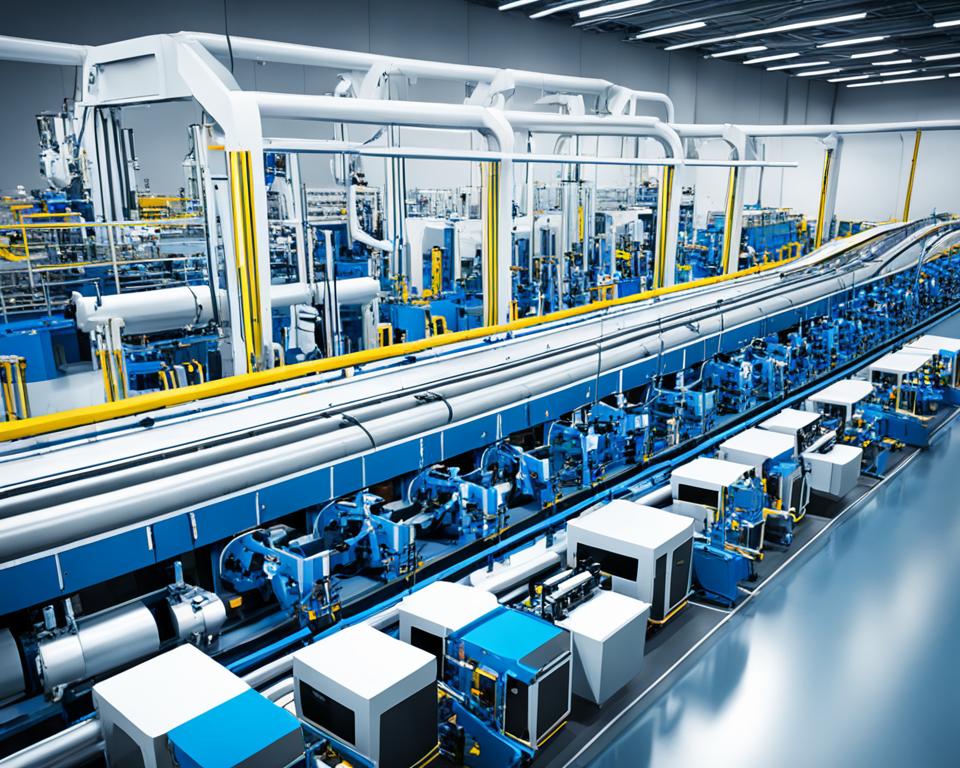In today’s competitive manufacturing landscape, organizations must optimize their production processes to stay ahead of the curve. Manufacturing Resource Planning (MRP) is a comprehensive system that provides the framework to achieve this objective. MRP integrates various aspects of the manufacturing process, including demand forecasting, inventory management, materials requirements planning, and capacity planning, to streamline operations and improve overall productivity.
Key Takeaways
- Manufacturing Resource Planning (MRP) is a critical system for optimizing production, enhancing efficiency, and boosting profitability in manufacturing organizations.
- MRP integrates demand forecasting, inventory management, materials requirements planning, and capacity planning to streamline operations and improve overall productivity.
- Effective implementation of MRP can lead to better inventory control, reduced lead times, improved customer service, and increased profitability.
- MRP is a key component of Enterprise Resource Planning (ERP) systems, which provide a holistic approach to managing all aspects of a manufacturing business.
- Adopting lean manufacturing principles and supply chain optimization strategies can further enhance the benefits of a well-designed MRP system.
Understanding Manufacturing Resource Planning
Manufacturing Resource Planning (MRP) is a powerful software-based system that helps manufacturers effectively manage their production activities. By providing real-time data on inventory levels, materials requirements, and production capacity, MRP systems enable businesses to optimize their operations and improve overall efficiency.
What is Manufacturing Resource Planning?
Manufacturing Resource Planning (MRP) is a production planning and inventory control system that is designed to manage the manufacturing process. MRP systems use computer-based algorithms to calculate the materials, components, and resources required to manufacture a product, based on production plans, orders, and inventory data. This information is then used to create detailed production schedules, purchase orders, and other key production management tools.
Benefits of Implementing MRP
- Improved inventory management: MRP systems help manufacturers maintain the right levels of inventory, reducing the risk of stockouts and excess inventory.
- Reduced production costs: By optimizing materials requirements and production scheduling, MRP can help businesses lower their overall production costs.
- Enhanced production scheduling: MRP provides real-time visibility into production capacity, enabling manufacturers to create more accurate and efficient production schedules.
- Better supply chain visibility: MRP systems integrate with other enterprise systems, providing greater visibility and coordination across the entire supply chain.
By implementing a comprehensive manufacturing resource planning system, businesses can unlock the full potential of their production operations and drive continuous improvement throughout their organization.

| Key Benefits of MRP | Description |
|---|---|
| Improved Inventory Management | MRP systems help maintain optimal inventory levels, reducing the risk of stockouts and excess inventory. |
| Reduced Production Costs | By optimizing materials requirements and production scheduling, MRP can lower overall production costs. |
| Enhanced Production Scheduling | MRP provides real-time visibility into production capacity, enabling more accurate and efficient scheduling. |
| Better Supply Chain Visibility | MRP systems integrate with other enterprise systems, improving visibility and coordination across the supply chain. |
Key Components of an Effective Manufacturing Resource Planning System
Manufacturers seeking to optimize their production processes must have a robust Manufacturing Resource Planning (MRP) system in place. At the heart of an effective MRP system are several key components that work together to streamline operations and improve overall efficiency.
Demand Forecasting and Production Planning
Accurate demand forecasting is crucial for effective production planning. By analyzing historical sales data, market trends, and customer behavior, manufacturers can predict future demand and create production schedules that align with customer needs. This helps to minimize waste, reduce inventory costs, and ensure timely product delivery.
Inventory Management and Materials Requirements Planning
Efficient inventory management and materials requirements planning (MRP) are essential for maintaining a steady flow of production. MRP systems monitor inventory levels, track material usage, and generate purchase orders for raw materials and components. This helps to ensure that the right materials are available at the right time, reducing production bottlenecks and minimizing the risk of delays.
| Component | Description | Benefits |
|---|---|---|
| Demand Forecasting and Production Planning | Predicting future demand and creating production schedules to meet customer needs | Minimizes waste, reduces inventory costs, ensures timely product delivery |
| Inventory Management and Materials Requirements Planning | Monitoring inventory levels, tracking material usage, and generating purchase orders for raw materials and components | Reduces production bottlenecks, minimizes the risk of delays |
By integrating these key components into a comprehensive manufacturing execution system, manufacturers can streamline their operations, improve productivity, and better respond to changing market demands.
Manufacturing Resource Planning Strategies for Optimizing Production
To fully maximize the benefits of Manufacturing Resource Planning (MRP), manufacturers must implement strategic approaches that optimize production and enhance overall efficiency. Capacity planning and scheduling are critical components in this process, enabling organizations to effectively manage their production resources and ensure they have the right capacity to meet customer demand.
Capacity Planning and Scheduling
Effective capacity planning involves analyzing production capabilities, forecasting demand, and aligning resources to meet anticipated needs. By leveraging MRP data, manufacturers can develop accurate schedules that optimize the use of equipment, labor, and materials. This not only improves on-time delivery but also reduces costly downtime and inventory carrying costs.
Supply Chain Optimization and Lean Manufacturing
Integrating supply chain optimization and lean manufacturing principles with MRP can further enhance efficiency. By streamlining the supply chain, manufacturers can reduce waste, improve responsiveness, and foster continuous improvement throughout the production process. Strategies such as just-in-time (JIT) inventory management, value stream mapping, and kaizen events can help organizations eliminate non-value-added activities and drive operational excellence.

